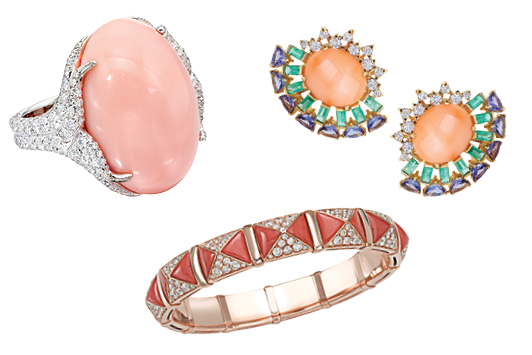
When Rui Galopim de Carvalho was a gemology student 30 years ago, his studies cited coral simply as coral, without additional qualifiers. What a difference a few decades make.
“Now we need to distinguish between common and precious coral. This is a recent reality in the past decade, since climate change has come up in the news,” says the Portuguese gemologist, writer and lecturer, who serves as vice president of the Coral Commission for the World Jewellery Confederation (CIBJO).
What most people think of as coral is actually the hard carbonate exoskeleton that the marine creatures known as corals secrete to protect themselves. Species like blue (helioporidae) and organ pipe (tubiporidae) coral are under threat from excessive heat as water temperatures rise, according to the US Fish and Wildlife Service’s Convention on International Trade in Endangered Species of Wild Fauna and Flora (CITES). The heat, along with the increasing acidity of the oceans, can lead to bleaching in the corals, a phenomenon that hastens their demise.
Indeed, when the climate change controversy and the safety of coral in the Great Barrier Reef became nightly news, the US jewelry industry vilified the material’s use. A campaign dubbed “Too Precious to Wear” cropped up against it. The initiative was the brainchild of Seaweb — a nonprofit group dedicated to advancing ocean conservation — and was championed by well-known jewelry designers and retailers.
But given the 2,500 species of corals in the world, coral producers and CIBJO are questioning just how much coral and which varieties are endangered. Are the at-risk common ones the same as the precious types used in jewelry?
Precious vs. common
“There is a misunderstanding that consuming corals is bad, but precious corals are a totally different species than reef corals,” argues Galopim de Carvalho. “There is a big concern about coral as a species, but only eight to nine species specifically are used in jewelry, and those ecosystems are thriving.”
Common corals are sponge, bamboo and blue — the ones mainly found in coral reefs. Precious corals “are limited to species belonging to the family Corallidae,” he recently wrote in an article for the International Colored Gemstone Association.
Jewelry coral, CIBJO maintains, is sustainable. The contents of its Coral Book, which it produced in the fall of 2017, and a report released at its annual congress around the same time, outline why the bulk of precious corals are responsibly harvested.
A significant difference between endangered coral and responsibly sourced jewelry coral is the depth at which they are found. The deeper they are, the colder the water, and the less risk they have of dying out from increasing temperatures.
“Coral to make jewelry is often located over 100 meters or more below the surface,” states the CIBJO report, adding that “fishing precious coral legally would not destroy the environment.”
A sea change?
However, one of the architects behind the “Too Precious to Wear” campaign remains unconvinced. Seaweb president and CEO Mark Spalding, who is also president of The Ocean Foundation, concedes there is some temperature protection for corals at 100 meters deep, but even if those corals aren’t subject to overheating, they’re needed in ecosystems for shelter. “Cold-water coral in the Bering Sea is probably safer than the Mediterranean, but my understanding is that Italy gets a lot of its red and pink coral from the Mediterranean, which is warming dramatically,” he says.
Yet Mediterranean red corals are not without protection. Recently enacted regulations by the United Nations’ General Fisheries Commission for the Mediterranean mandate that corals at 50 meters or deeper may only be harvested by divers with handheld gear, and those pieces must be at least 7 millimeters in diameter at the trunk.
Worth investing in
Despite the controversy — and perhaps in light of CIBJO’s recent efforts — some jewelry makers are investing heavily in coral. Italian brand Miseno is working more with it because it speaks to the company’s Naples heritage and the red corals found in the nearby Mediterranean Sea.
“We use it to tell the story of our city and to show the workmanship of what is done with coral,” explained the brand’s owner, Antonio Cardamuro, during a trade show this past winter. There’s been no resistance to it from clients, but then again, unlike bamboo and other reef-dwelling corals, it is not illegal to import. “Sardinian coral is okay to bring into the country,” he said.
Lifelong conservationist Christina Assael has invested so deeply in coral that she is adding it to her company’s tagline: “The Most Magnificent Pearls and Coral in the World.”
“Our coral is gem-quality and passes all the world’s standards on legal coral,” states Peggy Grosz, the New York-based jewelry house’s director of business development.
CIBJO, meanwhile, aims to please both sustainability advocates and jewelry lovers with its new SustainableCoral.org website, as well as stronger ties with scientists, academics and NGOs to better manage precious-coral resources.
Coral Commission president Vincenzo Liverino — who heads coral-producing company Enzo Liverino 1894 — is spending time with Naples University professors and other experts discussing the problem. Among the solutions under consideration is the use of DNA fingerprinting to track coral, which would let traders know whether it came from sites that follow CITES regulations. CIBJO is adamant about making the distinction.
“Just because a species shares a name doesn’t mean it’s all affected,” Liverino says.
Image: ShutterstockArticle from the Rapaport Magazine - September 2018. To subscribe click here.